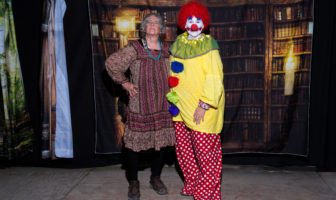As the SXSW Music Conference enters its 28th year, ATX Man looks at what it takes to make it as a breakout band in today’s Live Music Capital of the World.
By John T. Davis; Photos by Nicole Gell


That’s where we find the Nightowls, holding down a weekend residency at Icenhauer’s, in the heart of the Rainey Street District. They’re crammed on the tiny outdoor stage, the keyboard almost poking in to the neighbor’s yard, the horn players swiveling in tight lockstep, the singers practically sitting in the laps of the throng of hipsters sipping Lone Star tallboys and fruit jars full of sangria.
Though they have a new CD of original material, Good As Gold, under their belt, on this day, the Nightowls are leaning heavily on the Motown/Stax-Volt soul music canon: Martha and the Vandellas’ Nowhere To Run; Fontella Bass’ one-hit wonder, Rescue Me; Dusty Springfield’s Son of a Preacher Man and—for a giggling cohort of tipsy girls out for a bachelorette party—a leering version of Marvin Gaye’s belly-rubbing anthem, Let’s Get It On.
Though they’ve only been together a little more than two years, the band is tight, the horns vamping on cue, the rhythm section nailing down the bottom. And the slightly built vocalist at front and center is bringing it home with wounded fervor on a song from the new album: “I woke up this morning on the wrong side of the bed. Just gonna be one of those days.”
The singer is named Ryan Harkrider and, along with his musical and business partner, guitarist Amos Traystman, he assembled the Nightowls in 2011. With their tight-knit sax, trumpet and trombone brass section, their call-and-response female vocalists—one of whom, Ellie Carroll, is Harkrider’s wife—and their overriding affection for the lyrical joys and sorrows of classic R&B, the band fits nicely in to the timeless yet freshly fashionable fusion of pop, funk and soul popularized by the likes of Sharon Jones, John Legend and Adele, as well as locally, to greater and lesser extents, Nakia, T-Bird & the Breaks and Akina Adderley.


Now the question becomes: How the hell do you let people know about it? There are the band’s own gigs, of course—20 or so a month in Austin and cities throughout Texas. The 20th century dinosaur standbys of newspapers, magazines and commercial radio still exist in uneasy juxtaposition to social media like Facebook, Twitter, Vine, Instagram, Snapchat, YouTube and Buzzfeed. And there is satellite radio, along with online music services like iTunes, Spotify and Pandora.
Plus, roughly a jillion music blogs and websites, not including the band’s own. It’s exhausting and a little dispiriting. There’s never been more music at the fingertips of consumers and it’s never been harder for a musician or a band to break through the static. If standing out is the first imperative of making a successful career, how do you stand out?
“Good question! I have no idea,” says Harkrider.
It’s a few days later and Harkrider is sitting in the foyer of his publicist’s office. Good question or no, it’s clear that, despite his disclaimer, he’s given the matter a lot of thought.
“Being a dance band, we try to put on great shows and try to promote the album. That, for us, has been the best thing. We like to connect with people, and if we can get them out of their seats and moving, they can connect with us as a band, and that will connect them with our album,” Harkrider says.
“We work hard on the shows. Getting them there is one thing, but if you can’t get them there and impress them, it’s kind of all in vain,” Traystman adds.
That’s the classic old-school work ethic talking, but in the meantime, the band utilizes Facebook, Twitter and Instagram as well, not just to promote their gigs and music but, as Harkrider stresses, to create a personal connection. For instance, on a recent road trip to Houston, the band made a stop at Hruška’s, the beloved gas station and kolache emporium on Highway 71. They posted a photo of the joint on Instagram and fans responded.
“It’s a story,” Harkrider says. “Not only the story that the Nightowls are going to Houston to play a show, which is the information we want to convey, but also we want people to say, ‘I know that place! I love the kolaches!’ They can envision us driving in the van, listening to music, spotting the sign. … We want to create a narrative. There’s nine of us, so we try to have real stories.”
Spreading the band’s stories is a job for a publicist.
“We have to have a band that’s out there already playing and building their fan base before we can work with them. Bringing fans are the key. If they’ve got the wheel moving, we can grow that,” says Jill McGuckin, the founder of Austin-based McGuckin Entertainment PR.
In addition to the Nightowls, the company has worked with Patricia Vonne, Reckless Kelly, Ruby Jane, the Greencards and others.
“The one thing that sticks out for me with the Nightowls is that they ’re not afraid to work hard, and Ryan is very dedicated to making the band successful,” says Publicist Heidi Labensart, McGuckin’s associate. “The challenge for us is to find the right outlets to promote the band.”
McGuckin and Labensart are constantly vetting regional and national media outlets to track which are legitimate news purveyors and which are just piggybacking on other social-media feeds.
“A lot of media are lurkers,” McGuckin says. “They pick up as much from Twitter and Facebook as they do [from original sources].”


Those people who can help naturally include radio station music directors. Radio, whether online, via satellite or over the airwaves, still has an important role to play in an artist’s development, says Jeff McCord, music director at KUTX.
“The vast majority of listeners get their new music from radio, although that’s something we worry about with the younger demographic,” McCord says. “All we can do is counteract the reality that people have millions of pieces of music at their fingertips. Spotify has millions of songs, but if you don’t know where to go. … That’s where we feel we have the leg up. We spend a lot of time curating.”
McCord, like every other music director, is inundated with submissions every day.
“There’s not enough time in the world to listen to everything,” he acknowledges.
So he winnows the field in timeproven, old-fashioned ways: He talks to friends and peers whose opinions he respects. He reads the trades and keeps up with relevant websites like Pitchfork. He peruses articles people send him about trending bands (“If something’s going crazy, you hear about it,” he says.). He talks to folks at parties and in the clubs.
“I cobble all those things together and do the best I can to keep up,” he says with a rueful chuckle. “I’m not on social media all the time, but if something goes viral, somebody tends to talk to me about it. Or, I hear about it from my son.”
Musicians are sometimes their own worst enemies, he notes.
“I have to go after bands I’ve heard about, but they haven’t sent the station anything. Radio’s not on their radar, or barely so,” McCord says.
That’s not a mistake the Nightowls are apt to make.
“We have a very grassroots, DIY approach to radio and press,” Harkrider says. “We’re always walking it around, trying to make good contacts wherever we play. We work with the club owner: Who do you talk with? Who do you work with? Who can we give this to? We want to help you help us promote the show.”
How do you make an impression on a club owner or a booking agent?
“A band’s ability to promote, and how much effort they put in to their own shows goes a long way,” says Kristyn Ciani.
She should know. As a talent buyer for Austin entertainment giant C3 Presents, she booked the Nightowls at Stubb’s for the first time.
“Some artists don’t do much more than list a show on their blog or web page. Others take it to the next level. They’re out there on the streets with flyers and posters, they’re doing Facebook campaigns and getting their fans involved and engaged,” Ciani says. “They’re trying to work the press and the radio. Something good will eventually happen.”


Harkrider, like most of his peers, came of age in a different cultural universe, when MTV still played music videos, the local record store was the place to hang out, cell phones were just phones, not media hubs, and hit singles on the radio ruled the roost. An Austin native, the 28-yearold singer grew up in a musical environment. His parents were both church choir directors and he studied music, vocal performance and composition at the University of Texas. He started writing songs halfway through college.
Ironically, for an Austin musician, Harkrider missed some of the pivotal years of South By Southwest because the acapella group he performed with in college went on the road every spring break. He began his musical career as an Americana-style singer-songwriter and, indeed, he has a solo album in the can, but soul music had beckoned ever since he got a copy of the Jackson 5 Ultimate Collection album as a kid.
“Not only does singing soul music pair you with these fabulous musicians, but you learn firsthand how those songs are constructed and what works and what doesn’t, as far as song structure,” he says.
Harkrider and Traystman polished their soul music chops with the Matchmaker Band, an ensemble that runs on a parallel track with the Nightowls. The Matchmaker Band is an all-covers 10-piece group that plays mostly weddings and private parties. Harkrider and Traystman perform with both groups, although the Nightowls is a forum for original material, penned mostly by Harkrider, with arrangements by the band, versus the Matchmakers’ all-the-hits catalog.
“The approaches to the two bands are different, but the mindsets we have in terms of infrastructure are very similar,” Traystman says. “Everybody has different strengths. Ryan and I are more on the administrative/ visionary side.”
“Moving from the cover-band world to the indie/ original material world has been “a learning curve,” Traystman adds. “The biggest thing we have to set ourselves apart is that we’ve found a niche, stylistically. We want to put our own take on things but not compromise what makes that classic music so great.”
In addition to Harkrider and Traystman, the Nightowls also include vocalists Tara Williamson and Ellie Carroll, horn men Justin Smith, Jonathan McNutt and Javier Stuppard, bassist Rob Alton, drummer Ben Petree and Oscar Interiano on keyboards. Now, with their CD out and word-of-mouth spreading, Harkrider can focus on the next rungs on the ladder.
“We’ve got to be realistic with it. This is our first album, our first mark on the world. We haven’t showcased at South By Southwest, but we’ve got our name in the hat this year,” he says. “I’m from Austin, so I want to play at ACL and Blues on the Green. Those are my most immediate attainable goals. A year from now, the next piece of the puzzle, we would love to find a touring band—Raphael Saadiq or Sharon Jones and the Dap Kings would be great—and jump on with them, or put together our own tour.”
For the time being though, the Nightowls’ success is measured one new fan or successful gig or CD sale at a time. And that’s not something you can delegate to a publicist or a radio DJ or a social-media website.
“Amazon and iTunes are great platforms to connect with people all over the world,” Harkrider acknowledges. But you can’t autograph a download at the end of a sweaty night onstage and put it in someone’s hand. “It’s just real. To me, having a CD and being able to give it to you and look you in the eye and say thank you is something real and very important.”
“I think it’s the only way bands can make it these days,” says KUTX’s McCord. “They can’t wait around and rely on anything to happen. They’ve really got to have the smarts and the wherewithal and know the bases they need to cover. They’ve got to realize they’ve really got to work their butts off to do this.”
To paraphrase George Clooney’s character in A Perfect Storm, it’s not a work ethic, it’s just work. They may look sharp onstage, but Harkrider and the Nightowls aren’t afraid to roll up their sleeves and get their hands dirty. In the immortal words of Marvin and Tammi’s 1968 Motown hit, there ain’t nothin’ like the real thing.





